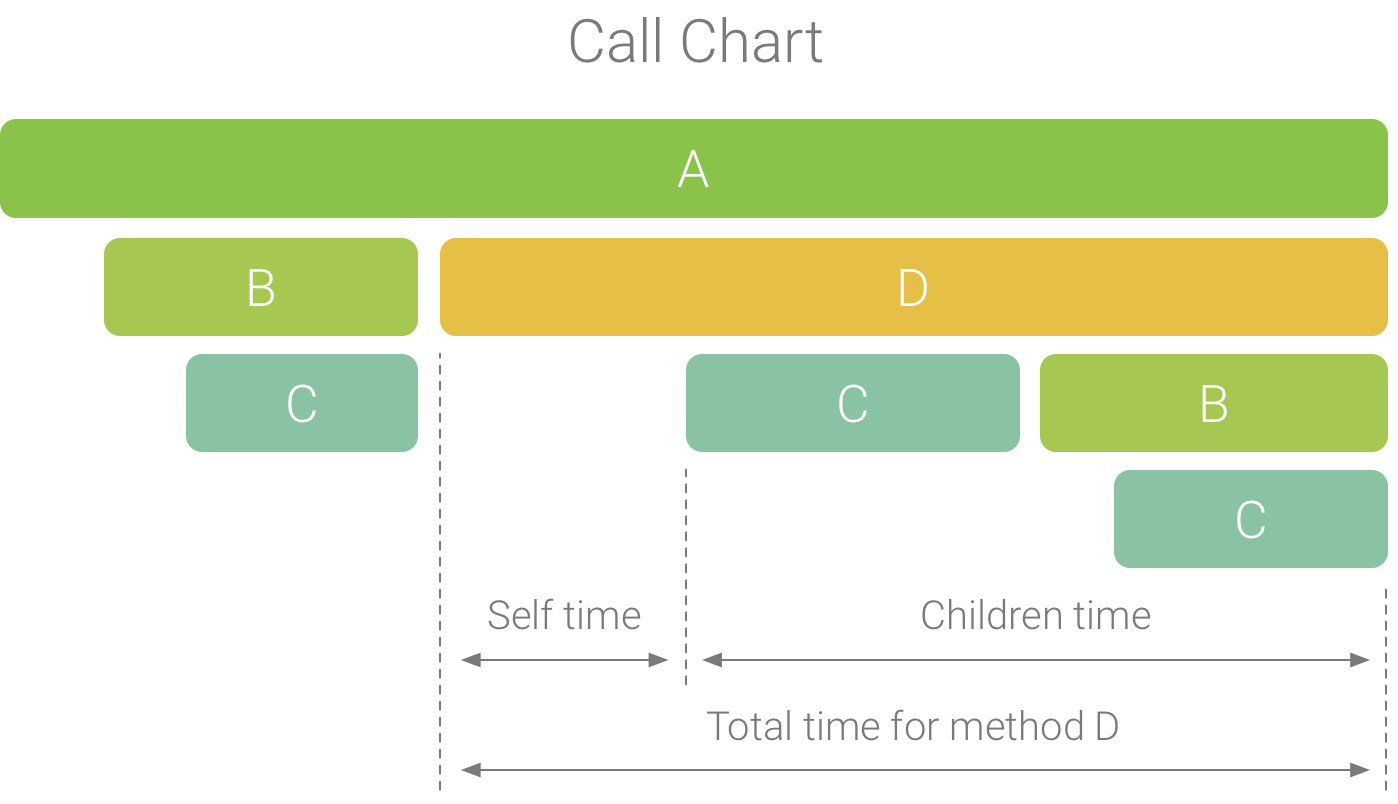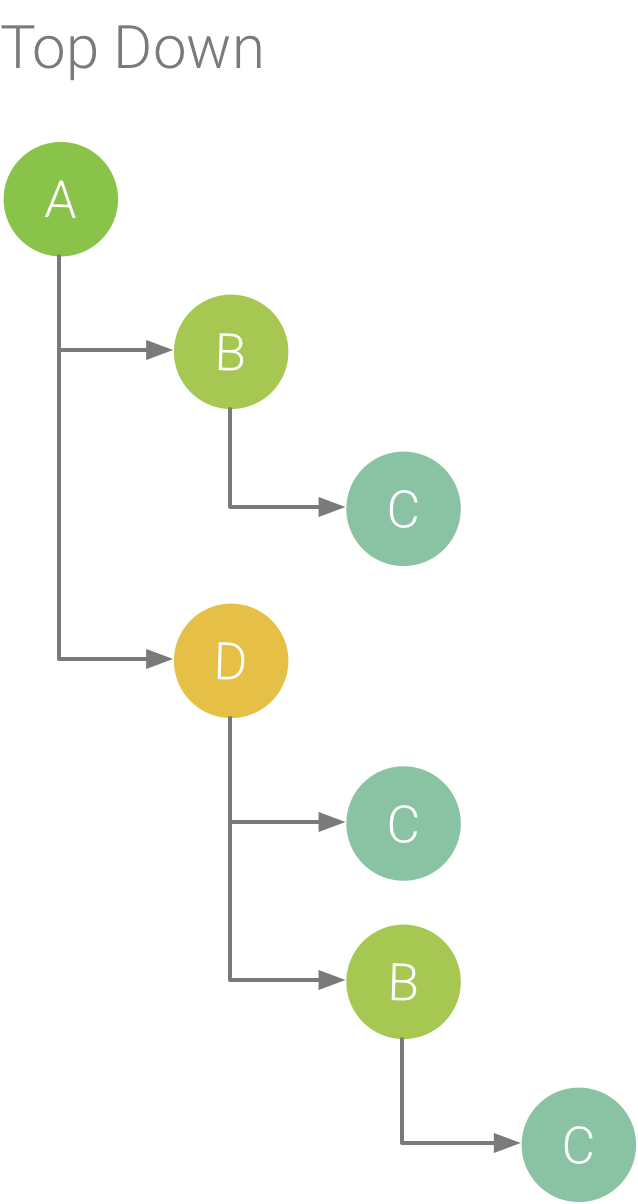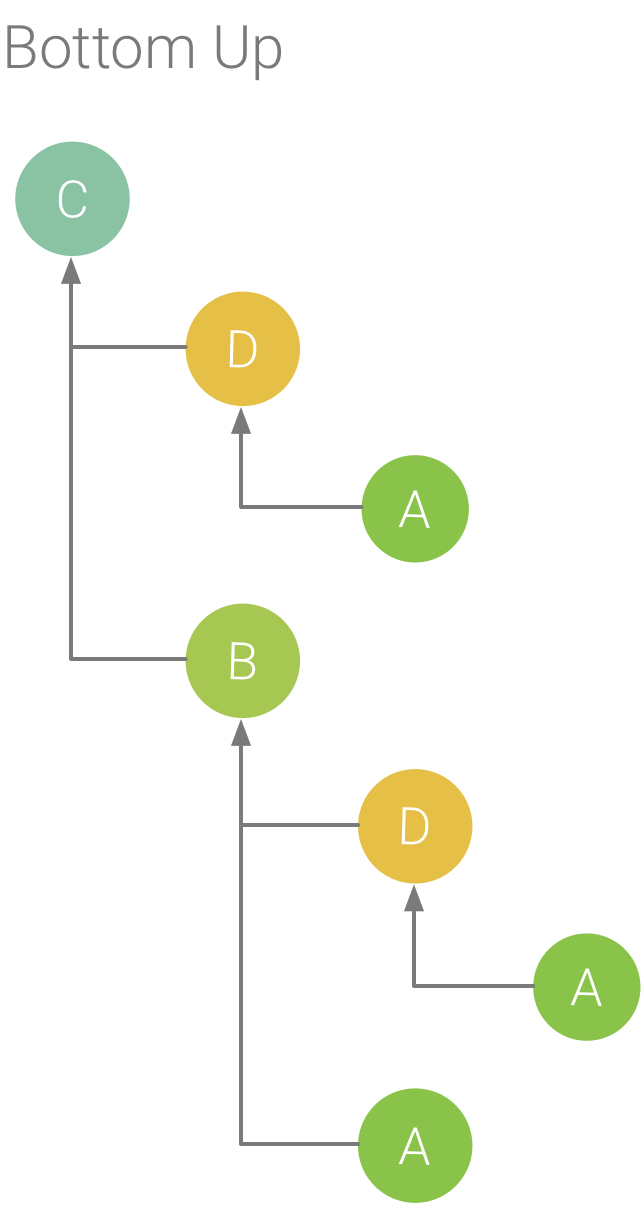แท็บจากบนลงล่างจะแสดงรายการการเรียกที่การขยายเมธอดหรือ โหนดฟังก์ชันจะแสดงผู้ถูกเรียก รูปที่ 2 แสดงกราฟจากบนลงล่างสำหรับแผนภูมิการเรียกใช้ต่อไปนี้ ลูกศรแต่ละอันในกราฟจะชี้จากผู้โทรไปยังผู้รับสาย

รูปที่ 1 แผนภูมิการโทรตัวอย่างที่แสดง เวลาของตัวเอง เวลาของลูก และเวลารวมสำหรับเมธอด D
ดังที่แสดงในรูปที่ 2 การขยายโหนดสำหรับเมธอด A ในแท็บจากบนลงล่าง จะแสดงเมธอด B และ D ซึ่งเป็นเมธอดที่เรียกใช้ หลังจากนั้น การขยายโหนดสำหรับเมธอด D จะแสดงผู้เรียกของเมธอดนั้น เช่น เมธอด B และ C คล้ายกับแท็บแผนภูมิเปลวไฟ ต้นไม้จากบนลงล่างจะรวบรวมข้อมูลการติดตามสำหรับเมธอดที่เหมือนกันซึ่งใช้สแต็กการเรียกเดียวกัน กล่าวคือ แท็บแผนภูมิเปลวไฟจะแสดงภาพกราฟิกของแท็บจากบนลงล่าง
แท็บจากบนลงล่างจะแสดงข้อมูลต่อไปนี้เพื่อช่วยอธิบายเวลา CPU ที่ใช้ในการเรียกแต่ละครั้ง (เวลาจะแสดงเป็นเปอร์เซ็นต์ของเวลาทั้งหมดของ เธรดในช่วงที่เลือกด้วย)
- ตนเอง: เวลาที่ใช้ในการเรียกใช้เมธอดหรือฟังก์ชันในการดำเนินการโค้ดของตัวเอง และไม่ใช่โค้ดของผู้ที่ถูกเรียก ดังแสดงในรูปที่ 1 สำหรับเมธอด D
- บุตรหลาน: เวลาที่ใช้ในการเรียกใช้เมธอดหรือฟังก์ชันในการดำเนินการ ผู้ถูกเรียกและไม่ใช่โค้ดของตัวเอง ดังแสดงในรูปที่ 1 สำหรับเมธอด D
- ทั้งหมด: ผลรวมของเวลาตนเองและบุตรหลานของวิธีการ ซึ่ง แสดงถึงเวลาทั้งหมดที่แอปใช้ในการดำเนินการโทร ตามที่แสดงใน รูปที่ 1 สำหรับวิธี D

รูปที่ 2 แผนผังจากบนลงล่าง

รูปที่ 3 แผนผังจากล่างขึ้นบนสำหรับเมธอด C จาก รูปที่ 5
แท็บจากล่างขึ้นบนจะแสดงรายการการเรียกที่การขยายฟังก์ชันหรือ โหนดของเมธอดจะแสดงผู้เรียก การใช้ตัวอย่างการติดตามที่แสดงในรูปที่ 2 รูปที่ 3 จะแสดงแผนผังจากล่างขึ้นบนสำหรับเมธอด C การเปิดโหนดสำหรับเมธอด C ในแผนภูมิด้านล่างขึ้นบนจะแสดงผู้เรียกที่ไม่ซ้ำกันแต่ละราย ซึ่งก็คือเมธอด B และ D โปรดทราบ ว่าแม้ B จะเรียก C 2 ครั้ง แต่ B จะปรากฏเพียงครั้งเดียวเมื่อขยายโหนดสำหรับ เมธอด C ในแผนผังจากล่างขึ้นบน หลังจากนั้น การขยายโหนดสำหรับ B จะแสดง ผู้โทรของโหนด ซึ่งก็คือเมธอด A และ D
แท็บจากล่างขึ้นบนมีประโยชน์ในการจัดเรียงเมธอดหรือฟังก์ชันตามรายการที่ใช้เวลา CPU มากที่สุด (หรือน้อยที่สุด) คุณสามารถตรวจสอบแต่ละโหนดเพื่อระบุ ผู้เรียกที่ใช้เวลา CPU มากที่สุดในการเรียกใช้เมธอดหรือฟังก์ชันเหล่านั้น เมื่อเทียบกับโครงสร้างแบบบนลงล่าง ข้อมูลเวลาสำหรับแต่ละเมธอดหรือฟังก์ชันในโครงสร้างแบบล่างขึ้นบนจะอ้างอิงถึงเมธอดที่ด้านบนของแต่ละโครงสร้าง (โหนดบนสุด) เวลา CPU ยังแสดงเป็นเปอร์เซ็นต์ของเวลาทั้งหมดของเธรดในระหว่างการบันทึกนั้นด้วย ตารางต่อไปนี้ช่วยอธิบายวิธีตีความข้อมูลเวลา สำหรับโหนดบนสุดและผู้เรียก (โหนดย่อย)
| ตนเอง | เด็ก | รวม | |
|---|---|---|---|
| วิธีการหรือฟังก์ชันที่ด้านบนของแผนผังจากล่างขึ้นบน (โหนดบนสุด) | แสดงเวลาทั้งหมดที่เมธอดหรือฟังก์ชันใช้ในการเรียกใช้ โค้ดของตัวเอง ไม่ใช่โค้ดของผู้ที่เรียกใช้ เมื่อเทียบกับแผนภูมิต้นทาง ข้อมูลการจับเวลานี้แสดงถึงผลรวมของการเรียกทั้งหมดไปยังเมธอดหรือฟังก์ชันนี้ ตลอดระยะเวลาการบันทึก | แสดงเวลาทั้งหมดที่เมธอดหรือฟังก์ชันใช้ในการเรียกใช้ ผู้ถูกเรียกและไม่ใช่โค้ดของตัวเอง เมื่อเทียบกับแผนภูมิต้นไม้จากบนลงล่าง ข้อมูลการจับเวลานี้แสดงถึงผลรวมของการเรียกทั้งหมดไปยัง วิธีการหรือฟังก์ชันที่เรียกใช้ในช่วงระยะเวลาของการบันทึก | ผลรวมของเวลาของฟังก์ชันเองและเวลาของฟังก์ชันย่อย |
| ผู้โทร (โหนดย่อย) | แสดงเวลาที่ใช้ด้วยตนเองทั้งหมดของผู้ถูกเรียกเมื่อผู้เรียกเรียก การใช้แผนผังจากล่างขึ้นบนในรูปที่ 6 เป็นตัวอย่าง เวลาของเมธอด B จะเท่ากับผลรวมของเวลาของเมธอดเอง สำหรับการดำเนินการแต่ละครั้งของเมธอด C เมื่อ B เรียกใช้ | แสดงเวลารวมของบุตรหลานของผู้รับสายเมื่อผู้โทรเรียกใช้ การใช้แผนผังจากล่างขึ้นบนในรูปที่ 6 เป็นตัวอย่าง เวลาของบุตรหลานสำหรับเมธอด B จะเท่ากับผลรวมของ เวลาของบุตรหลานสำหรับการดำเนินการแต่ละครั้งของเมธอด C เมื่อเรียกใช้โดย B | ผลรวมของเวลาของฟังก์ชันเองและเวลาของฟังก์ชันย่อย |
หมายเหตุ: สำหรับการบันทึกที่กำหนด Android Studio จะหยุดรวบรวมข้อมูลใหม่ เมื่อโปรไฟล์เลอร์ถึงขีดจำกัดขนาดไฟล์ (แต่การดำเนินการนี้จะไม่หยุด การบันทึก) โดยปกติแล้ว การดำเนินการนี้จะเกิดขึ้นเร็วกว่ามากเมื่อทำการติดตามที่มีการวัดประสิทธิภาพ เนื่องจากประเภทการติดตามนี้จะรวบรวมข้อมูลได้มากกว่าในเวลาที่สั้นกว่าเมื่อเทียบกับการติดตามแบบสุ่มตัวอย่าง หากคุณขยายเวลาการตรวจสอบเป็น ระยะเวลาของการบันทึกที่เกิดขึ้นหลังจากถึงขีดจำกัด ข้อมูลเวลาใน แผงการติดตามจะไม่เปลี่ยนแปลง (เนื่องจากไม่มีข้อมูลใหม่) นอกจากนี้ แผงการติดตามจะแสดง NaN สำหรับข้อมูลการจับเวลาเมื่อคุณเลือกเฉพาะ ส่วนของการบันทึกที่ไม่มีข้อมูล

